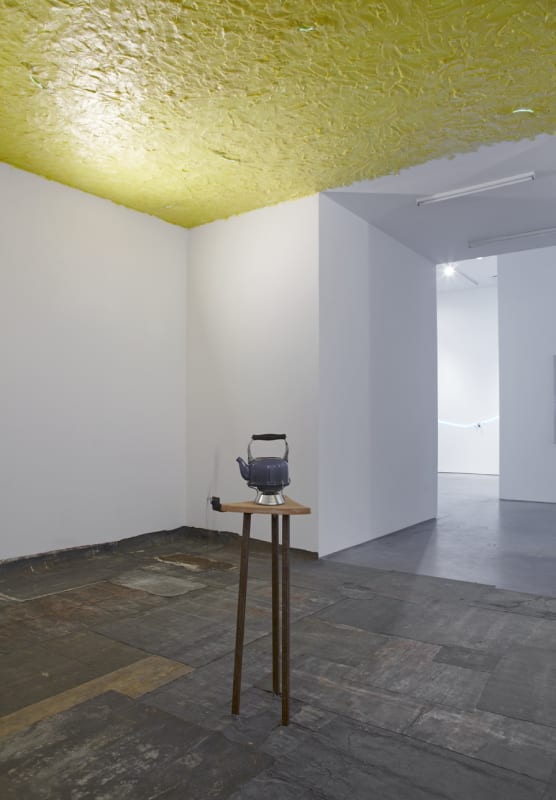BY MICHAËL AMY
Pier Polo Calzolari, like Arte Povera (the movement with which he is associated), is insufficiently valued in the U.S. Some critics deem the Italian movement - with its emphasis on base materials and their interactions - hokey and pompous, a preferably forgotten chapter in the history of postwar art. But at its best, Arte Povera has produced some of the most gripping art of the past half-century, and Calzolari's strongest works would stand their ground in the finest collections of contemporary art. If you embrace the cold, cerebral, and doctrinaire aesthetic of ludd at the expense of all else, then Arte Povera will seem both rhetorical and lacking in purity. If you have a taste for Rauschenberg' image-riddled "Combines" and their progeny, Arte Povera will seem inadequate to the task of handling contemporary life, and, therefore, inauthentic.
However, Rauschenberg's magical handling of materials, his seemingly boundless powers of invention, and his early monochrome pictures inspired Calzolari, as did, I would argue, the work of Alberto Burri and of Joseph Beuys. Arte Povera's principal theme seems a melancholic weighing of the past. Its stark juxtaposition of materials brings to mind abandoned factories, the cavernous rooms of old palazzi, and the weathered surfaces of ancient ruins -and it is in just such spatial contexts that Arte Povera really ignites. Yes, it is nostalgic, but it can also achieve the epic, sadness-tinged proportions of Fellini's La Dolce Vita, Visconti's I Gattopardo, or the work of Cy Twombly. And the same applies to Calzolari's finest works.
At Boesky, one was quickly confronted with the mysterious Untitled Work in progress from a 1970s project) (1988-2012), with the ceiling of the space unevenly covered in rich yellow wax, from which emerged occasional curving strips of blue neon - a thick, golden sky streaked with flashes of light. The floor below was covered with overlapping rectangular sheets of lead that curved up the base of the walls, likewise evoking softness, warmth, and protection - though some believe that lead poisoning led to the decline of the Roman Empire. A material later used by Zorio, Kiefer, and Forg, lead was used regularly by Calzolari for its meanings and material beauty. A Beuysian symbolism, steeped in myth and/or history, seemed present in this space with its leaden floor and fatty ceiling. A steaming kettle, raised up on a tripod and seemingly causing a small rod to spin, added another piece to the puzzle. Though I am familiar with the layout of the Boesky gallery, I became disoriented as I proceeded through it. An opening had been cut through the wall separating Boesky and Pace, thereby creating a dreamlike spatial extension that became an integral and unforgettable part of the aesthetic experience.
Calzolari continues to introduce new media in meaningful ways, while handling familiar materials in unorthodox ways. The monumental Untitled (2008) achieves great power through apparently the simplest of means. This diptych consists of two joined sheets of felt that were burned, thereby causing them to warp. Their forward projection is echoed toward the top of the composition by three leather belts tied as if around three imaginary waists, with the straps hanging loose in front. The felt achieves the look of burnt earth. In other works, Calzolari torched vast expanses of salt, thereby transforming it into a velvety substance. Who would have thought?
Aside from lead, salt (burnt or raw), and torched felt, refrigeration units constitute another important part of Calzolari's formal language. They are particularly effective in Untitled (Mattress: "Senz'altri rumori che i miei" (1971), in which a large mattress hangs horizontally across the wall, slightly compressed by three refrigerated lines at either end, while the Italian verse of the title cuts across the field, spelled out in blue neon. Suddenly, in light of this work, the large expanses of other compositions become the tops of beds or sheets- you want to lie down on them, lose yourself in them, and dream away.
Calzolari is interested in rendering white, black, and gray without resorting to paint. The thing itself (white salt, gray lead), burnt material (salt, felt, or wood turned black), or a freezing line of metal (the opposite of burning, for white), does the trick. The last technique is used, sparingly, in Mattress, where the two sets of three thin frost lines are surrounded by brown stains of condensation. Here, beauty, danger, the abject, and the worlds of myth and dreams successfully come together. "When the dreamer dies, what happens to the dream?" constituted a much-needed introduction to an important artist with a fine sense of proportion and scale, in addition to a solid understanding of the eloquence of un-modulated, or dramatically altered, substances.


